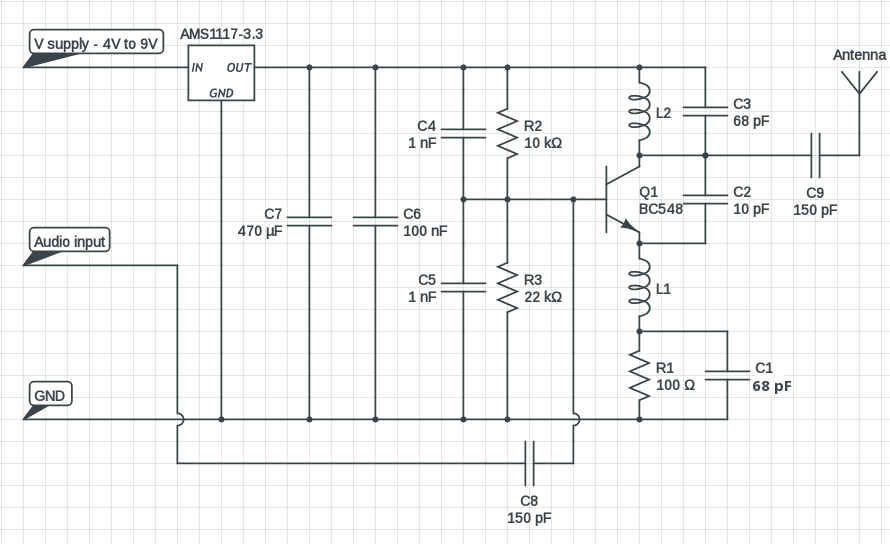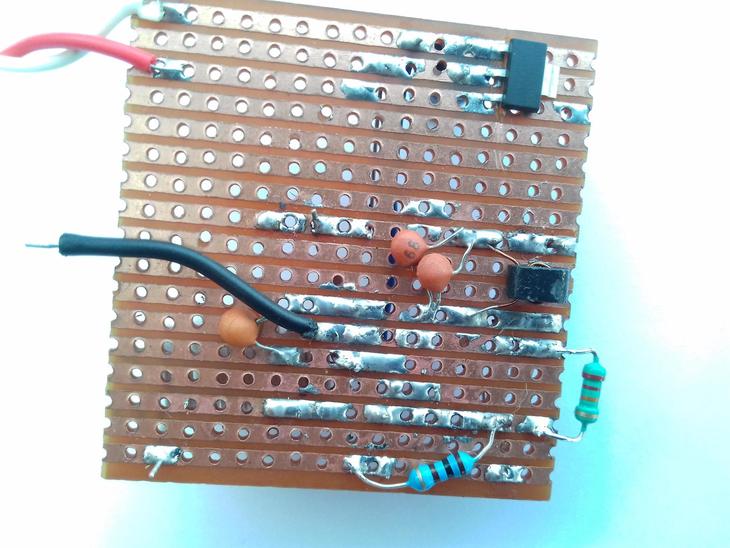| |
FM transmitter circuit projects are indeed quite popular among electronics hobbyists / students. But the frustrating part is most transmitters refuses to work at all, and secondly the internet is full of crappy transmitter circuits. Designing a stable FM transmitter circuit is rather a difficult job, many calculations are involved their. There are also some construction error and component value tolerance. Here you can find a reasonably stable and well tested transmitter that actually works.

First of all, have a look at the circuit diagram. It’s basically a common base collpit oscillator transmitter.
FM transmitter part list
R1 – 100 Ohm, carbon film 1/4 watt
R2 – 10 kOhm, carbon film 1/4 watt
R3 – 22 kOhm, carbon film 1/4 watt
C1 – 68 pF, ceramic disc
C2 – 10 pF, ceramic disc
C3 – 68 pF, ceramic disc
C4 – 1 nF, ceramic disc
C5 – 1 nF, ceramic disc
C6 – 100 nF, ceramic disc
C7 – 470 uF, 10V electrolytic
C8 – 150 pF, ceramic disc
C9 – 150 pF, ceramic disc
L1 – 11.5 turn on 6 mm diameter, see text below
L2 – 3 turn on 3×2 mm ferrite bead, see text below
Q1 – BC548 transistor
U1 – AMS1117-3.3 LDO regulator
So, it uses 16 components excluding the wires, connectors and circuit board. As always, you can replace all the components with their nearest value counterparts. The antenna is just a peace of 75 cm single stranded wire, technically a quarter wave whip antenna. The coil L2 is specially important, it’s winded on a ferrite bead. The bead MUST be a RF ferrite bead, else the circuit wont work. You can salvage them from old TV balun, TV tuner box, DVD RF box, radios and so on. The coil L1 is winded over 6 mm diameter, 11.5 turns of single stranded hookup wire. It’s basically a RF choke coil. You can use any 3.3 volt LDO regulator instead of the AMS1117-3.3, but definitely not a Zener diode and resistor combo to get the regulated voltage.
Construction
You’ve to pay a little attention while constructing RF related circuits.
- Component leads should be trimmed to minimal.
- There should be no or lowest possible capacitance between two PCB tracks, anyway this can’t be avoided.
- Use as tittle solder as possible.
- Clean the solder flux thoroughly after soldering, preferably with alcohol.
- All components should be soldered tightly.
- Finally, enclose it inside a little metal case if possible.
I had constructed the circuit on a strip board, which is not fit for this purpose. Also messed up all the above rules, due to an extensive trial end error to find the right component values. But finally it worked, now the FM transmitter circuit is reasonably stable, without any frequency drifting. You can see the little ferrite bead in the above picture.
So why this miniature FM transmitter circuit is reasonably stable? I did some research and calculations before making the final circuit and choosing the components. I’m not going to extensive details, but these are main reasons why this transmitter is stable.
- A simple common base Collpits oscillator is a voltage controlled linear harmonic oscillator. In fact the frequency modulation is achieved by the varying voltage at the transistor’s base, due to varying P-N junction capacitance. So for a stable operation I’ve to keep the supply voltage as stable as possible.
- All oscillators generate some order harmonics along with the fundamental frequency. So I’ve to choose such a transistor which can operate at the fundamental frequency of the LC tank circuit, but not at the 2nd harmonic. BC548 is a good candidate for this purpose, which has a transition frequency of around 100 MHz, but also a larger noise figure.
- Ferrite cores tends to absorb higher frequencies much more than lower frequencies. Thus by using a ferrite core inductor at the LC tank circuit, it it minimizes the 2nd order and 3rd order harmonics further.
- Ferrite core inductors also tends to have higher Q factor than air core inductors, so the coil also improves the transmitter’s quality.
Range test and future improvement plans
Undoubtedly it’s a very low power FM transmitter circuit, it’s intended for stability, not range. In my tests it’s transmitting not more than 20 meters, but the audio quality is good enough, and no frequency drifts observed. But increasing the range is rather simple than increasing stability, it just needs a buffer stage and RF amplifier. It’s also transmitting AM waves, as the modulating signal is directly fed into the base of the transistor, though the AM modulation index is quite low. I’m planning to use a varactor diode for FM modulation in the future design.

Related Links
Downloads
Stable FM Transmitter - Link
|
|
|
| |
Accurate LC Meter
Build your own Accurate LC Meter (Capacitance Inductance Meter) and start making your own coils and inductors. This LC Meter allows to measure incredibly small inductances making it perfect tool for making all types of RF coils and inductors. LC Meter can measure inductances starting from 10nH - 1000nH, 1uH - 1000uH, 1mH - 100mH and capacitances from 0.1pF up to 900nF. The circuit includes an auto ranging as well as reset switch and produces very accurate and stable readings. |
|
PIC Volt Ampere Meter
Volt Ampere Meter measures voltage of 0-70V or 0-500V with 100mV resolution and current consumption 0-10A or more with 10mA resolution. The meter is a perfect addition to any power supply, battery chargers and other electronic projects where voltage and current must be monitored. The meter uses PIC16F876A microcontroller with 16x2 backlighted LCD. |
|
|
|
60MHz Frequency Meter / Counter
Frequency Meter / Counter measures frequency from 10Hz to 60MHz with 10Hz resolution. It is a very useful bench test equipment for testing and finding out the frequency of various devices with unknown frequency such as oscillators, radio receivers, transmitters, function generators, crystals, etc. |
|
1Hz - 2MHz XR2206 Function Generator
1Hz - 2MHz XR2206 Function Generator produces high quality sine, square and triangle waveforms of high-stability and accuracy. The output waveforms can be both amplitude and frequency modulated. Output of 1Hz - 2MHz XR2206 Function Generator can be connected directly to 60MHz Counter for setting precise frequency output. |
|
|
|
BA1404 HI-FI Stereo FM Transmitter
Be "On Air" with your own radio station! BA1404 HI-FI Stereo FM Transmitter broadcasts high quality stereo signal in 88MHz - 108MHz FM band. It can be connected to any type of stereo audio source such as iPod, Computer, Laptop, CD Player, Walkman, Television, Satellite Receiver, Tape Deck or other stereo system to transmit stereo sound with excellent clarity throughout your home, office, yard or camp ground. |
|
USB IO Board
USB IO Board is a tiny spectacular little development board / parallel port replacement featuring PIC18F2455/PIC18F2550 microcontroller. USB IO Board is compatible with Windows / Mac OSX / Linux computers. When attached to Windows IO board will show up as RS232 COM port. You can control 16 individual microcontroller I/O pins by sending simple serial commands. USB IO Board is self-powered by USB port and can provide up to 500mA for electronic projects. USB IO Board is breadboard compatible. |
|
|
|
|
ESR Meter / Capacitance / Inductance / Transistor Tester Kit
ESR Meter kit is an amazing multimeter that measures ESR values, capacitance (100pF - 20,000uF), inductance, resistance (0.1 Ohm - 20 MOhm), tests many different types of transistors such as NPN, PNP, FETs, MOSFETs, Thyristors, SCRs, Triacs and many types of diodes. It also analyzes transistor's characteristics such as voltage and gain. It is an irreplaceable tool for troubleshooting and repairing electronic equipment by determining performance and health of electrolytic capacitors. Unlike other ESR Meters that only measure ESR value this one measures capacitor's ESR value as well as its capacitance all at the same time. |
|
Audiophile Headphone Amplifier Kit
Audiophile headphone amplifier kit includes high quality audio grade components such as Burr Brown OPA2134 opamp, ALPS volume control potentiometer, Ti TLE2426 rail splitter, Ultra-Low ESR 220uF/25V Panasonic FM filtering capacitors, High quality WIMA input and decoupling capacitors and Vishay Dale resistors. 8-DIP machined IC socket allows to swap OPA2134 with many other dual opamp chips such as OPA2132, OPA2227, OPA2228, dual OPA132, OPA627, etc. Headphone amplifier is small enough to fit in Altoids tin box, and thanks to low power consumption may be supplied from a single 9V battery. |
|
|
|
|
|
Arduino Prototype Kit
Arduino Prototype is a spectacular development board fully compatible with Arduino Pro. It's breadboard compatible so it can be plugged into a breadboard for quick prototyping, and it has VCC & GND power pins available on both sides of PCB. It's small, power efficient, yet customizable through onboard 2 x 7 perfboard that can be used for connecting various sensors and connectors. Arduino Prototype uses all standard through-hole components for easy construction, two of which are hidden underneath IC socket. Board features 28-PIN DIP IC socket, user replaceable ATmega328 microcontroller flashed with Arduino bootloader, 16MHz crystal resonator and a reset switch. It has 14 digital input/output pins (0-13) of which 6 can be used as PWM outputs and 6 analog inputs (A0-A5). Arduino sketches are uploaded through any USB-Serial adapter connected to 6-PIN ICSP female header. Board is supplied by 2-5V voltage and may be powered by a battery such as Lithium Ion cell, two AA cells, external power supply or USB power adapter. |
|
200m 4-Channel 433MHz Wireless RF Remote Control
Having the ability to control various appliances inside or outside of your house wirelessly is a huge convenience, and can make your life much easier and fun. RF remote control provides long range of up to 200m / 650ft and can find many uses for controlling different devices, and it works even through the walls. You can control lights, fans, AC system, computer, printer, amplifier, robots, garage door, security systems, motor-driven curtains, motorized window blinds, door locks, sprinklers, motorized projection screens and anything else you can think of. |
|
|
|